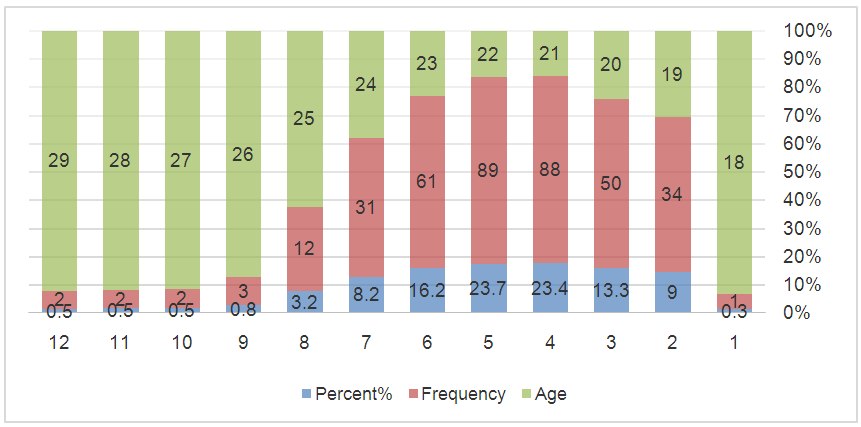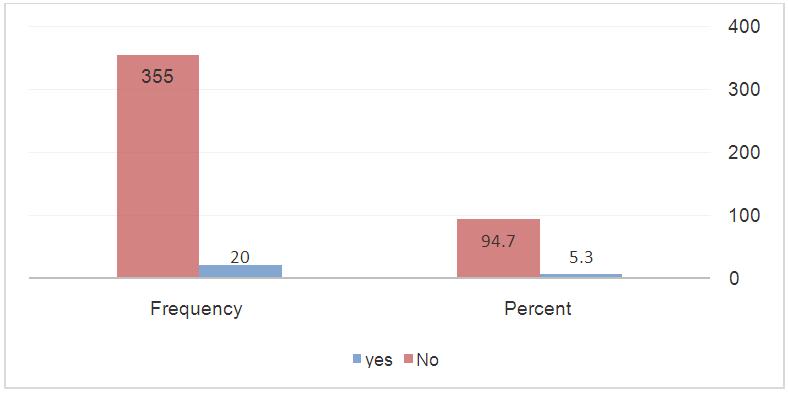-
Paper Information
- Previous Paper
- Paper Submission
-
Journal Information
- About This Journal
- Editorial Board
- Current Issue
- Archive
- Author Guidelines
- Contact Us
American Journal of Medicine and Medical Sciences
p-ISSN: 2165-901X e-ISSN: 2165-9036
2017; 7(1): 14-19
doi:10.5923/j.ajmms.20170701.04

Prevalence of Cruciate Ligaments Injury among Physical Education Students of Umm Al-Qura University and the Relation between the Dominant Body Side and Ligament Injury Side in Non-Contact Injury Type
Waleed Alghamdi, Abdulaziz Alzahrani, Abdulbaqi Alsuwaydi, Ahmed Alzahrani, Osama Albaqqar, Mohammed Fatani, Hussain Alaidarous
College of Medicine, Umm AL-Qura University, Makkah, Saudi Arabia
Correspondence to: Waleed Alghamdi, College of Medicine, Umm AL-Qura University, Makkah, Saudi Arabia.
| Email: |  |
Copyright © 2017 Scientific & Academic Publishing. All Rights Reserved.
This work is licensed under the Creative Commons Attribution International License (CC BY).
http://creativecommons.org/licenses/by/4.0/

This research will estimate the number of the physical education students at Umm Al Qura university who had cruciate ligaments injury including both ligaments anterior as well as posterior cruciate ligament, and based on the number of the students who had a non-contact injury type, which means there were no body to body contact that participated or involved directly or indirectly in the mechanism of the injury In the non-contact injury type, we will see if there is any relation between the dominance effect of the upper and lower limb side to the side of the injured cruciate ligament.
Keywords: Cruciate ligaments injury, Anterior cruciate ligament, Posterior cruciate ligament, Student
Cite this paper: Waleed Alghamdi, Abdulaziz Alzahrani, Abdulbaqi Alsuwaydi, Ahmed Alzahrani, Osama Albaqqar, Mohammed Fatani, Hussain Alaidarous, Prevalence of Cruciate Ligaments Injury among Physical Education Students of Umm Al-Qura University and the Relation between the Dominant Body Side and Ligament Injury Side in Non-Contact Injury Type, American Journal of Medicine and Medical Sciences, Vol. 7 No. 1, 2017, pp. 14-19. doi: 10.5923/j.ajmms.20170701.04.
Article Outline
1. Introduction
- Cruciate ligaments are two ligaments inside the capsule of the knee joint, these ligaments are strong and cross each other hence called cruciate. These tow ligaments connect the tibia with the femur and play an important function in the stability of the knee joint. Anterior cruciate ligament is attached to the tibia at the intercondylar region in its anterior part and attached at the medial side of the lateral femoral condyle at its posterior part.The posterior cruciate ligament is attached to the tibia at the intercondylar region in its posterior part and attached at the lateral side of the medial condyle at its anterior part. The function of these ligaments is to prevent anterior or posterior femur displacement over the tibia or the opposite. The cruciate ligaments function is mainly to stabilize the knee and these ligaments have a risk to be injured in the athletes as well as non-athletes.The incidence of anterior cruciate ligament injury, which accounts to be involved in the majority of cruciate ligament injury by 100,000 to 200,000 [1, 2]. Most of these injuries occurred as non-contact injury [3]. Non-contact cruciate ligaments injury could result from quick sudden deceleration, hyperextension or sudden rotation and these could happen during a game. Analytic video studies of athletes who had a non-contact injury type showed a similar mechanism of lower leg motion during the injury period, specifically the joint motion. These mechanisms were mostly similar between male and female. The authors believe that non-contact injury type can be a preventable event to the athletes [3, 4].A meta-analysis of the incidence of anterior cruciate ligament tears in relation to gender, type of sport involved and the knee injury-reduction regimen showed that female prone to anterior cruciate ligament injury three times more than male especially in soccer and basketball and the injury-reduction regimen was effective in soccer but was not in basketball [5].Multiple studies with different controversial result done to show any relation between the dominance of the body side and the cruciate ligament injury side. Most of the studies involved female as a sample but less involved male as a sample. The difference between dominant and non-dominant leg may play a role in any injury type not specific the cruciate ligaments. Most of the players have a preferred leg, which they used most of the time for kicking and passing in the soccer as an example. A study involved 41 volunteered showed different muscle group strength between the dominant and the non-dominant leg. The knee flexor muscles group was significantly weaker in the dominant than the non-dominant leg. This variation can lead to a muscular imbalance, which is generally considered as an injury risk factor. [6]. Leg dominance may play a role in cruciate ligaments injury with variation between the gender. A retrospective observational study involved 58 soccer players who sustained a non-contact anterior cruciate ligament injury showed that the female was more prone to sustain an anterior cruciate ligament injury in their non-dominant supporting leg and represent about 68%, while male players were in their dominant leg and represent about 74,1% [7].While in another retrospective case series analysis done on 80 patients 44 were male and 36 were female, the result showed that the limb dominance including upper and lower limb is not a significant etiologic factor for non-contact ACL tears, and the gender has no significant effect on the relationship between the injury side and the limb dominance [8]. A retrospective case analysis with higher sample number and involved both male and female supporting that there is no relation between the dominant lower limb side and cruciate ligament injury side and no significant effect of gender type on that relation, but the female showed to have significant involvement of the left anterior cruciate ligament more than the right cruciate ligament [9]. Valgus knee motion and angle that contribute to the non-contact cruciate ligament injury during jumping and landing were studied. Eighty-one basketball players volunteered in this study and the result showed that the female athletes landed with greater valgus knee motion and angle than the male athletes. Also, the female had a significant valgus knee angle between their dominant and non-dominant side [10]. Forward landing comparing to drop landing exhibited higher knee valgus asymmetry and hip adduction in both male and female but it was more in the female [11]. Different prevention programs have been applied to decrease the risk of cruciate ligaments injury mainly the anterior cruciate ligament and based on the systemic review of the literature on the anterior cruciate ligament injury prevention, the conclusion was these programs have substantial benefits in injury prevention and the risk was reduced by 52% in the female athletes and by 85% in the male athletes [12].A neuromuscular training program with training might help in decreasing the incidence number of the cruciate ligament injury and its associated effects on athletes [13].In this study we will address the prevalence of cruciate ligaments injury and will see if there is any significant relation between the dominancy of the body side and the side of cruciate ligaments injury.
2. Methodology
- A retrospective cross-sectional study based on a questionnaire distributed to the students of physical education college at Umm Al-Qura university and filled by them. The questionnaire contained multiple-choice questions, which were close-ended questions. No personal, social or private questions were involved. The questionnaire involved questions about the most dominant side in the body used to play any sort of sports, specifically dominant side used for kicking, throwing, holding and writing, ligament injury side (right or left knee), mechanism of injury (contact or not), type of ligament involved in the injury and the way of diagnosis (clinically or imaging). All students who had cruciate ligaments injury despite the type of it were involved in the analysis of the prevalence of the injury, but the relation between the dominant body side and injury side the only included in the analysis were the students who had non-contact injury type but their number were not that high. Data analysis was done by SPSS. The prevalence was calculated mathematically by dividing the number of injured students to the total number of participant students and by using the frequencies in the SPSS. For the relation between the dominant body side which identified by based on throwing, holding, writing and kicking side and the injury side as either right or left knee side, the analysis done by using Pearson's Chi square test (2X2 table).
3. Result
- 375 students involved in the prevalence analysis with variation in the age between 18 to 29 years old, most of them were nineteen to twenty-five year old and the highest was 22 years old (Figure 1). 20 student had cruciate ligament injury out of 376, which was 5.3%, while the remaining 356 had not, which represent 94.7% (Figure 2). Most of the injuries involved the anterior cruciate ligaments, which were 12 out of 20, while two were involved the posterior and the remaining six do not know injured ligament (Figure 3). Right knee was involved in 14 injuries while six were left knee (Figure 4). Twelve injuries were contacted type while eight were non-contacted type (Figure 5). In non-contact injury type, six students using their right foot for kicking as the dominant side while tow students using their left side. Half of the students had cruciate ligaments injury at the same side of their dominant foot and the other half at the non-dominant foot (Table 1).
 | Figure 1. The distribution of the sample according to the age |
 | Figure 2. The distribution of the sample according to the cruciate ligament injury |
 | Figure 3. The distribution of the sample according to cruciate injury type |
 | Figure 4. The distribution of the sample according to knee injury side |
 | Figure 5. The distribution of the sample according to the injury type |
|
|
|
|
4. Discussion
- Cruciate ligament injury is a common injury among the athletes and results in a future inability of the athletes to exercises and play as they used to even after reconstruction and repair and might end up his career if that is his or her job. Non-contact cruciate ligament injury type which represents the majority type of cruciate ligament injury might be a preventable injury in the future. Despite that the majority of cruciate ligament injury is a non-contact type, in this study we found that the majority is contact type and this could be due to the sports type which the athletes involved in, playground or aggressiveness during the game. The number of non-contact injury type in the sample was not so high, and that affect the statistical result of the relation between the dominant body side and cruciate ligament injury side. Although, this theory is still controversial and all the previous research showed conflict result.
5. Conclusions
- There is no clear number to compare the prevalence result.The prevalence in our selected sample was 5% among the athletes. Most of the cruciate ligaments injuries were a contact type 60%.There was no significant relation between the dominant body side and the side of knee injury (p = 0.889) for the dominant body side for kicking and (p = 0.381) for throwing, handling and writing. The number of contact injury type is more than non-contact type and that could be because of the sports type, violence during the game, playground type and other factors.
6. Recommendations
- - More researches to determine the most common type of cruciate ligaments injury among the athletes in Saudi Arabia.- Causes of increasing number of contact injury type and solution for that.- More researches with higher number involving in the study to determine the significant of dominant body side to the cruciate ligament injury.- Determined and looking for other modifiable factors that could help to decrease the number of cruciate ligaments injury among the population.
ACKNOWLEDGEMENTS
- Thank you for Dr. Adel AL Shehri and Mohammed Alharbi for the technical help and writing assistance.
 Abstract
Abstract Reference
Reference Full-Text PDF
Full-Text PDF Full-text HTML
Full-text HTML


